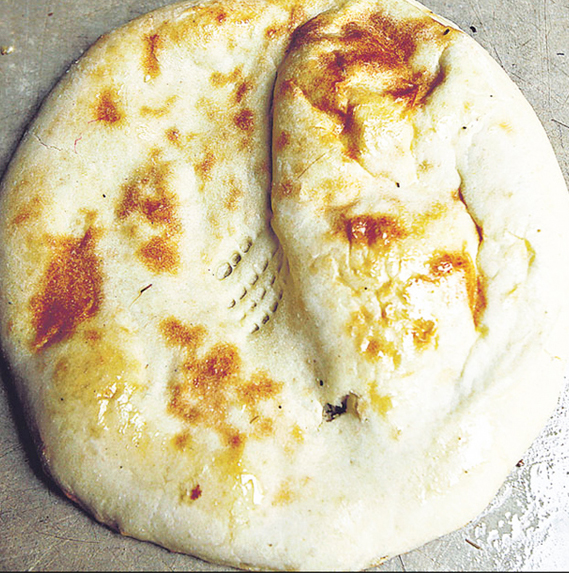Mama’s Punjabi Recipes: Khamiri Roti (Sourdough Wheat Flatbread)
In our ancestral home in Lyallpur, Punjab along the banks of the river Jhelum, during the summer months the temperatures would get so high that it wouldn’t be unusual if any atta (dough) left uncooked would naturally rise overnight. Though not frequent, the women folk wouldn’t panic, and instead would roll khamiri rotis (sourdough bread) out of the dough and cook them in the tandoor, which, of course, every home had.
Years later now, many people live in crowded cities and don’t have home tandoors anymore. And though they might leave the atta in the fridge, after a few days it will turn khamiri due to the natural fermentation process. But most young cook aren’t aware of the how to handle the atta and simply throw it away, even though it cooks just as well on a tava (flatplate) or skillet and looks like a pita bread when finally ready.
However, the soft, sponginess and slightly tangy taste of khamiri rotis has always appealed to people. Most people nowadays, including most restaurants, hurry up the process by adding yeast or baking soda to the atta while kneading and setting it aside to let the dough rise.
There is another side to khamiri roti that many do not realize. The yeast itself has nutritional value: it provides higher immunity by providing 9 amino acids the human body cannot produce and high in protein and vitamin B1 and B2. It is the closest type of leavened bread that can be made on a tava (flat skillet). This is the Indian version of sourdough bread and tastes best with curried dishes and daals.
Ingredients:
2 cups atta (unbleached wheat flour). Makes 10 rotis
2 cups pani (water)
Tael (oil – use olive oil) for cooking
Directions:
1. Pour the atta in a bowl and mix well. Slowly pour the water in while kneading the dough, adding the oil to make it softer, till it becomes a nice, tender but firm ball. . If the dough is too hard, the roti will also be hard. Note: This recipe does not use any baking soda.
2. Dab the surface of the ball with a little water to keep it moist, cover the bowl and set aside in a warm place or wrapped with a couple of towels for at least 2 hours.
3. Check to see if the dough has started to have large pores, rise a little and become slightly spongy to touch. This means that the natural yeast has started to ferment. If not, then let it stay a little longer.
4. Coat your palms with a little dab of oil so that the dough will not stick to them. Uncover the bowl, and pinch off a portion of the dough and make into a 2 inch round ball.
5. Pour a little dry flour on the counter and roll the ball in it to coat it. Now use a velna (rolling pin) to roll the ball into a nice round, flat pancake, about 1/8 inch thick.
6. Place the tava on the stove and heat on medium and coat with a small dab of oil. Now carefully place the flattened dough on the tava. Once the dough starts to show some bubbles, then turn it over and coat with a little oil. Let the other side also cook till bubbles appear. Now flip the dough again and when you see small brown spots, gently press the top with a flat spatula.
7. Take the khamiri roti off the tava and keep on the side. Both sides should be a little crispy. If it is overcooked it will show large dark spots. Cover with a clean soft cloth to keep warm; do not place in a plate right away as the roti will shed some water vapor.
8. Now repeat the process till the rest of the rotis are made and the dough is finished.
MAMA’S TIP OF THE WEEK
EAT SOAKED AND PEELED ALMONDS FOR BREAKFAST AND GOOD HEALTH
Since millennia, our sages have preached that badam (almonds) are beneficial for your health. Now, we know that they are full of protein, fiber, omega-3 and -6 fatty acids, vitamin E, magnesium, calcium and zinc. If you eat a dozen in the morning, this will start you off on a balanced diet for the rest of the day.
Soaking almonds is good as it helps the body absorb the vitamins and nutrients more quickly. Although peeling them reduces the fiber, it reduces tannic acid and an enzyme inhibiting substance in the brown coating which keeps the almond intact until it is ready to sprout into a tree. But this only works for almonds that are not pasteurized or roasted.
Soak the almonds overnight and peel them in the morning. If they don’t pop out of the brown coating, then boil some water and let them soak in it for 5 minutes. The coating will peel off right away!
Shakuntla Malhotra is a skilled cook of Punjabi dishes made in the old-fashioned style that she learnt as a young woman in her ancestral home in Lyallpur, India before it became part of Pakistan after the Partition in 1947. People have often admired her cooking for its simplicity and taste that comes with each mouthful. Even in her mid-eighties, she continues to cook daily and agreed to share some of her delectable Punjabi recipes.


